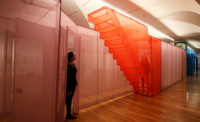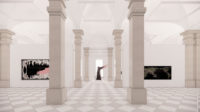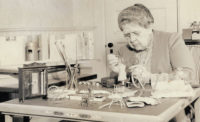Over the next nine months, an artful taste of the Nevada desert experience that is Burning Man will occupy the Renwick Gallery and its surrounding neighborhood in the heart of Washington, D.C.’s Golden Triangle. In “No Spectators: The Art of Burning Man,” the Renwick Gallery—which is the Smithsonian American Art Museum’s branch dedicated to contemporary craft—plays host to a wide variety of artworks ranging in complexity and scale from jewelry and clothing to oversized sculpture and a virtual reality walkthrough of what Burning Man attendees affectionately refer to as “the playa.”
Every year since 1986, Burning Man has set up a temporary city for a weeklong festival; since 1990, these have been held in Nevada’s Black Rock Desert (except in 1997, when it was held in the Hualapai Desert, a few miles northwest of Black Rock). These transient desert conclaves, hosting some 70,000 annual visitors, occupy pentagonal sites, with an arched plan that centers on the Burning Man—an anthropomorphic wooden sculpture that is burned at the conclusion of the event in keeping with a “leave no trace” ethos that serves as one of the festival’s 10 guiding principles—and a temple, which is likewise constructed of wood and subject to conflagration.
“The idea that you create the world that you want to live in is something that we really ought to be talking about here in our nation’s capital,” says exhibition curator Nora Atkinson. She explains that the show pulls its title from another playa tenet: “No spectators” refers to the idea that all visitors should be fully involved, present, and active contributors to their experiences, as opposed to mere observers of them.
Sculptor David Best, who has designed several temples for Burning Man, worked with a team of some 20 artists to install a custom-fit wooden temple within the Renwick Gallery’s grand salon. “David has been very thoughtful in how he has syncopated these columns and made these mini-altars. He’s left our wonderful cornice visible, and even his grand ceiling piece has peekaboo glimpses of our skylight and the molding that makes this room so special,” Smithsonian director Stephanie Stebich said at the opening. “It’s a great conversation between past and present.”
Perhaps the most interactive of the pieces is a set of three glowing, kinetic mushrooms activated by footpads. Developed by FoldHaus Art Collective, Shrumen Lumen comes alive when a visitor steps on a footpad at the base of each: once activated, these membranes expand and contract, illuminated within by pulsating, color-changing LEDs. Motion and mobility play large roles in the desert city during Burning Man festivals, with vehicles limited to bicycles and “mutant vehicles”—several of which, modified beyond recognition of make or model, are on display on the museum’s first level.
In partnership with Washington’s Golden Triangle Business Improvement District—a corporation aimed at enhancing a 43-block area that includes the commercial corridor lining Pennsylvania Avenue to the immediate northwest of the White House as well as the southern part of Dupont Circle—the Renwick Gallery has also launched “No Spectators: Beyond the Renwick,” which installs six large-scale sculptures within the Golden Triangle BID to extend the exhibition into the community. “When you put something out in the street, often what you’re doing is intervening in people’s regular path,” says Kim Cook, who is Burning Man’s director of art and civic engagement. “When you alter people’s pathways, you break cycles. When people pause, or connect and marvel, you’ve just changed the experience of public space.”
Outside the Renwick Gallery, a pair of 12-foot long bronze crows (Untitled, 2017, by Jack Champion) sits along Pennsylvania Ave opposite the World Bank; late-evening commuters hustling underground at the Farragut West and Farragut North Metro stations will have their paths illuminated by a large X and O (XOXO, by Laura Kimpton) at the former, and a faceted and filigreed lantern (Golden Spike, 2015, by HYBYCOZO) at the latter. “Coming upon these works where they’d least expect them, and standing in awe, people who would not normally talk to each other comment to the person next to them,” says Golden Triangle BID executive director Leona Agouridis. “Suddenly they’re in conversation, and that’s pretty powerful.”
“No Spectators: The Art of Burning Man,” will be on view at the Smithsonian’s Renwick Gallery from March 30, 2018 through January 21, 2019.










